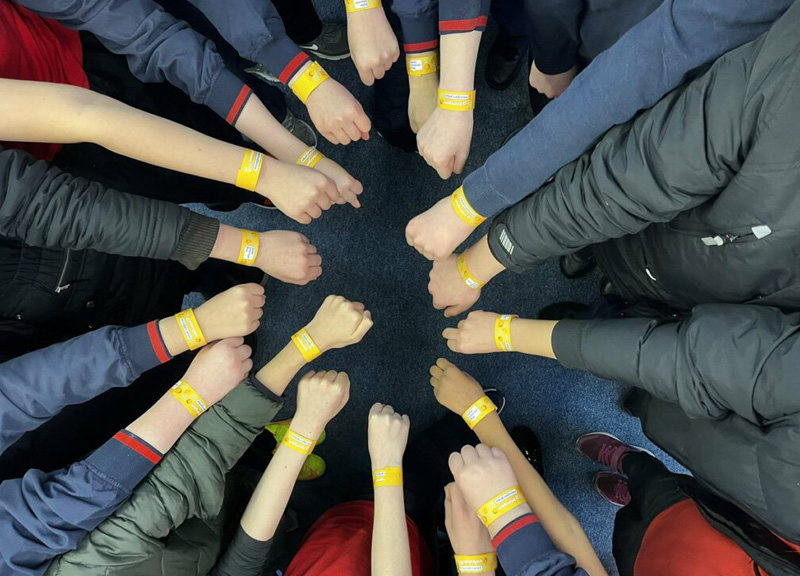Lesson 3: Victim Blaming
This lesson gives students an opportunity to explore the issue of victim blaming, which can often arise when incidents of non-consensual sharing have occurred.
Students will be able to respond in a sympathetic, effective and non-victim blaming manner to witnessing or being involved in incidents of non-consensual sharing.
- +Curriculum Links
-
- Junior Cycle SPHE Short Course Strand 3:
Team up: Media influence on relationships and sexuality
Junior Cycle SPHE Modules: Relationships and sexuality; Friendship, Influences and decisions
-
- +Differentiating this lesson for students with SEN
- Consider using the pictures in this resource to explain the concept of victim blaming. This may be essential if the student’s ability to process information, read social cues or make abstract connections is diminished in some way.Activity 2: Asking For It is optional. The reading age of the extract is approximately 16 years so is more suitable for use with older students or with students of high ability.
- +Resources and Methodologies
-
- For Your Eyes Only video animation
(available to watch and download at www.webwise.ie/lockers)
- For Your Eyes Only video animation
Worksheet 3.1: Dear Bronagh
Extract from Asking for it by Louise O’Neill
- Methodologies: Video analysis, reading comprehension, class discussion
-
- +Teachers’ Note
- It is advisable to read the best-practice guidelines before engaging in lesson delivery. Before leading any of the activities included in this resource, it’s important that you have established clear ground rules with the class and that students see the SPHE class as an open and caring environment. Take the time to outline the supports available to students (both inside and outside of school), should they be affected by any of the issues discussed in the class and need to talk to someone. Highlight the fact that if there are any disclosures indicating underage sexual activity, you will be obliged to report the incident to the Designated Liaison Person. It is best to try to avoid discussing real cases, familiar to the students, and instead to focus discussions on the cases presented in the lessons.
- +Activity 3.1 - Victim Blaming
- STEP 1: Re-watch For Your Eyes Only (www.webwise.ie/lockers). In For Your Eyes Only, Seán’s defence was that Bronagh shouldn’t have sent the sexts in the first place. This is an example of victim blaming.
- STEP 2: Throughout history and in modern day society, there are countless examples of cases where the victim is held responsible for his/her own violation. Have you ever heard the phrase “oh, he/she was asking for it”? Often times that phrase can indicate a case of victim blaming. Victims of rape are sometimes blamed for their own rape because of their choice of clothing or because they didn’t fight back. People feel that a person who gets beaten up or mugged while walking home late at night should have known better than to walk through a dangerous area. When money is stolen from a locker in school, the victim can sometimes be blamed for being careless and leaving the locker unlocked in the first place. A guy who gets knocked out by his opponent on a football pitch can be blamed for taunting or mouthing off in the first place.
- STEP 3: Lead a class discussion on the following questions:Q. Can you give other examples of victim blaming?Q. Why do you think Seán and the other students were inclined to blame Bronagh for what happened?
Sample answer: Seán was inclined to blame Bronagh for what happened to deflect the blame and protect himself. One of the reasons why the other students might have blamed Bronagh was to distance themselves from what happened. Doing this might have given the other students a false sense that this would not have happened to them. Another reason why people blame a victim is because they fear change and don’t want to highlight the crime that has taken place.Q. Do you think the comments written on the lockers were fair?
Sample answer: The comments written on the lockers were extremely hurtful. The name-calling that Bronagh endured is never justified and is a form of bullying that should be reported to school management immediately. Some people might argue that Bronagh must take a certain level of personal responsibility for what happened, given the fact that she took the photo in the first place. However, Bronagh never gave consent for the photo to be shared and could not have imagined that the photo would be shared as it was. - STEP 4: Have the students imagine they are Bronagh’s friend. Have the students use Worksheet 3.1 to write a note to Bronagh, expressing their support and advising her on where to go for help. It might be useful to distribute the list of helping organisations found in Appendix 2.
- +Activity 3.2 - Asking for it
- STEP 1: Have students read the extract from Louise O’Neill’s book, Asking For It. When an 18-year-old girl is raped by members of the local football team, her community turns on her. Pictures of the boys violating the victim, Emma, are shared all over social media and yet the community justifies their footballing heroes’ behaviour by blaming Emma for being drunk, for wearing provocative clothes, for “asking for it”. This extract from the book is an opinion piece that appears in the local newspaper.
- STEP 2: After reading the extract, have students consider the impact that victim blaming and reading the newspaper article might have on Emma, the victim of rape. Discuss this issue, using the following questions to lead the discussion.
Q. How might Emma feel, having read this article?
Q. Why do you think people blame victims for the crime that has been committed against them?
Sample answer: One reason people blame a victim/survivor is to distance themselves from an unpleasant occurrence. This gives people a false sense that this could not happen to them. Another reason why people blame a victim is because they fear change, are ashamed and don’t want to highlight the crime that has taken place.
Q. Explain how the extract is an example of victim blaming.
Sample answer:The author of this piece is very selective about the details she includes in the piece. She highlights the poor emotional well-being of a bereaved mother to encourage the
reader to sympathise with the accused. Meanwhile she never describes how the victim, Emma, or her family have been affected by the crime. Instead the journalist uses a hyperbolic final sentence to place the blame for the crime firmly on the victim and thus manipulates her readers into agreeing with her vein of thought. - STEP 3: Have the students prepare a television news report on the Ballinatoom case. The case is about to be heard in court. In the report the students must avoid victim blaming and should also avoid using language that might prejudice the case.






